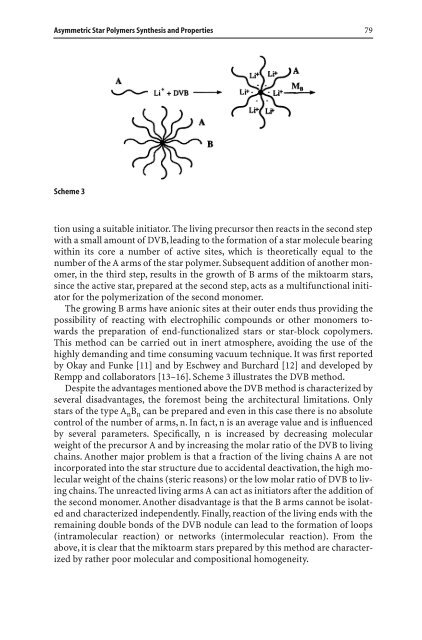142 Advances in Polymer Science Editorial Board: A. Abe. A.-C ...
142 Advances in Polymer Science Editorial Board: A. Abe. A.-C ...
142 Advances in Polymer Science Editorial Board: A. Abe. A.-C ...
You also want an ePaper? Increase the reach of your titles
YUMPU automatically turns print PDFs into web optimized ePapers that Google loves.
Asymmetric Star <strong>Polymer</strong>s Synthesis and Properties 79<br />
Scheme 3<br />
tion us<strong>in</strong>g a suitable <strong>in</strong>itiator. The liv<strong>in</strong>g precursor then reacts <strong>in</strong> the second step<br />
with a small amount of DVB, lead<strong>in</strong>g to the formation of a star molecule bear<strong>in</strong>g<br />
with<strong>in</strong> its core a number of active sites, which is theoretically equal to the<br />
number of the A arms of the star polymer. Subsequent addition of another monomer,<br />
<strong>in</strong> the third step, results <strong>in</strong> the growth of B arms of the miktoarm stars,<br />
s<strong>in</strong>ce the active star, prepared at the second step, acts as a multifunctional <strong>in</strong>itiator<br />
for the polymerization of the second monomer.<br />
The grow<strong>in</strong>g B arms have anionic sites at their outer ends thus provid<strong>in</strong>g the<br />
possibility of react<strong>in</strong>g with electrophilic compounds or other monomers towards<br />
the preparation of end-functionalized stars or star-block copolymers.<br />
This method can be carried out <strong>in</strong> <strong>in</strong>ert atmosphere, avoid<strong>in</strong>g the use of the<br />
highly demand<strong>in</strong>g and time consum<strong>in</strong>g vacuum technique. It was first reported<br />
by Okay and Funke [11] and by Eschwey and Burchard [12] and developed by<br />
Rempp and collaborators [13–16]. Scheme 3 illustrates the DVB method.<br />
Despite the advantages mentioned above the DVB method is characterized by<br />
several disadvantages, the foremost be<strong>in</strong>g the architectural limitations. Only<br />
stars of the type A n B n can be prepared and even <strong>in</strong> this case there is no absolute<br />
control of the number of arms, n. In fact, n is an average value and is <strong>in</strong>fluenced<br />
by several parameters. Specifically, n is <strong>in</strong>creased by decreas<strong>in</strong>g molecular<br />
weight of the precursor A and by <strong>in</strong>creas<strong>in</strong>g the molar ratio of the DVB to liv<strong>in</strong>g<br />
cha<strong>in</strong>s. Another major problem is that a fraction of the liv<strong>in</strong>g cha<strong>in</strong>s A are not<br />
<strong>in</strong>corporated <strong>in</strong>to the star structure due to accidental deactivation, the high molecular<br />
weight of the cha<strong>in</strong>s (steric reasons) or the low molar ratio of DVB to liv<strong>in</strong>g<br />
cha<strong>in</strong>s. The unreacted liv<strong>in</strong>g arms A can act as <strong>in</strong>itiators after the addition of<br />
the second monomer. Another disadvantage is that the B arms cannot be isolated<br />
and characterized <strong>in</strong>dependently. F<strong>in</strong>ally, reaction of the liv<strong>in</strong>g ends with the<br />
rema<strong>in</strong><strong>in</strong>g double bonds of the DVB nodule can lead to the formation of loops<br />
(<strong>in</strong>tramolecular reaction) or networks (<strong>in</strong>termolecular reaction). From the<br />
above, it is clear that the miktoarm stars prepared by this method are characterized<br />
by rather poor molecular and compositional homogeneity.
















